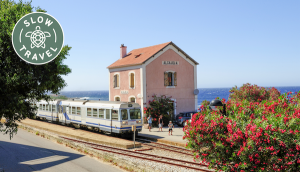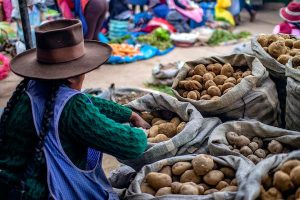
Bountiful seafood and rich produce from the interior of Spain combine to create one of the world’s great cuisines. Inventive chefs and a wealth of regional variety add to the allure, all of which make eating here a memorable part of the Spanish travel experience.
Meals come in many varieties, from bite-sized morsels of perfection at a tapas or pintxos bar to multi-course feasts overlooking the seaside. You’ll also find great wines, sprawling food markets and plenty of unique snacks to tide you over between the big meals. The convivial atmosphere also plays a role: Spaniards love to dine out, and it’s impossible not to feel the buzz when delving into the country’s gloriously diverse dining scene.
Get local insight on destinations all over the world with our weekly newsletter delivered to your inbox. 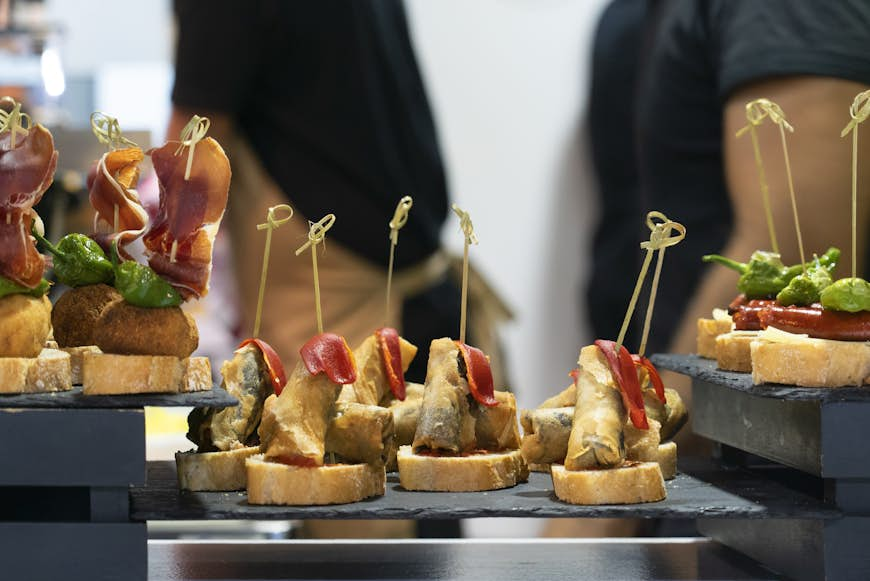 Small bites (
Small bites (
Go on a tapas (or pintxos) tasting
One of the world’s most enjoyable dining experiences, eating tapas – small snack plates – is a way of life in Spain. For the uninitiated, these bite-sized snacks are typically delivered in waves, often in noisy bars, where they are washed down with glasses of local vino in marathon sessions that can last for hours.
The dishes served as tapas vary widely depending on where you are in the country. In the white villages and historic towns of Andalucía, expect the best jamón (ham) and fine Spanish olives – Moorish-influenced Granada is famed for its pinchos morunos (spiced pork skewers) and montaditos (stacked open sandwiches secured with a toothpick).
In San Sebastián and elsewhere in the Basque Country, the most popular small bites are pintxos, named for the “spike” that often holds them together. Here, the snack is elevated to high culinary art, with treats such as txuleta (aged beef steak), txangurro (spider crab) tartlets and wild mushroom croquettes with Idiazabal cheese.
Where to try it: In Madrid, you can munch on a wide range of delicacies all in one compact area at the historic Mercado de San Miguel. A chalkboard menu showcases changing daily dishes (like slow-roasted duck or terrines of foie gras) at San Sebastián’s Bar Borda Berri.
Sip a glass of Rioja in Spain’s wine-making heartland
La Rioja is the sort of place where you can spend weeks meandering along quiet country roads and ducking into small vineyards in search of the finest drop. The mainstays for oenophiles in this region are small bodegas (wine cellars) offering wine tastings and picturesque villages with excellent wine museums and wine-centric festivals.
Where to try it: At the Frank Gehry-designed Hotel Marqués de Riscal, you can take a tour of the famous winery, then sip outstanding reds in the tasting room afterward. There are great wine bars all over the region. Sample excellent Riojas (and munch on tapas) at La Tavina in Logroño.
Have a seafood feast on the coast
Seafood is a consistent presence along both the Atlantic and Mediterranean coasts. You’ll find a wide range of specialties, which vary from region to region. The region of Galicia has some of Spain’s best seafood, particularly when it comes to pulpo (octopus). The star is pulpo á feira (spicy boiled octopus). You’ll see it branded as pulpo a la gallega or pulpo gallego in other parts of Spain. The constituent elements (octopus, oil, paprika and garlic) are simple but the execution is devilishly difficult.
Further south, Andalucia has a dizzying variety of fresh fish and shellfish, with snack food favorites like pescaíto frito (fried fish) and regional treats such as Bay of Cádiz shrimp and baby squid. A particular specialty of Cádiz, Andalucian-style “fried fish” can be prepared with just about anything that emerges from the sea, rolled in chickpea and wheat flour, then deep-fried ever so briefly in olive oil, just long enough to form a light, golden crust that seals the essential goodness of the fish or seafood within.
Where to try it: Near the seaside in the Costa Brava town of Calella de Palafrugell, the much-loved La Blava serves Mediterranean seafood with Catalan accents. In Malaga, La Pelegrina Centro specializes in small plates so you can try a wide range of seafood delicacies.

Bite into a tender serving of jamón
There’s no more iconic presence on the Spanish table than cured ham from the high plateau – the sight of jamónes hanging from the ceiling of a local deli is one of Spain’s most enduring images. Unlike Italian prosciutto, Spanish jamón is a bold, deep red and well-marbled with buttery fat. At its best, it smells like meat, the forest and the field.
The best-quality jamón is most commonly eaten as a starter or a ración (large tapa). On menus, it’s usually called a tabla de jamón ibérico (or ibérico de bellota). Spaniards almost always eat it with bread, and it goes amazingly well with Spanish cheeses such as manchego.
Where to try it: You can find quality jamón all over the country, with specialty purveyors like Claudio: La Feria del Jamón Bar in Bilbao and Alma de Julián Becerro in Madrid serving rich, wafer-thin slices.
Enjoy an anytime snack of tortilla de patatas
Great for vegetarians and carnivores alike, the tortilla de patatas (often called simply “tortilla“) is a Spanish egg-and-potato omelet that’s especially good when the eggs are still creamy. You’ll often find tortilla served as an in-between-meals snack or offered up at room temperature as a tapas dish although it can be a meal in itself.
Where to try it: This Spanish staple crops up almost everywhere, but it was first recorded in the region of Navarra, which is still a fine place to sample it. Bar La Navarra in Pamplona serves a creamy, rich tortilla that embodies perfection.
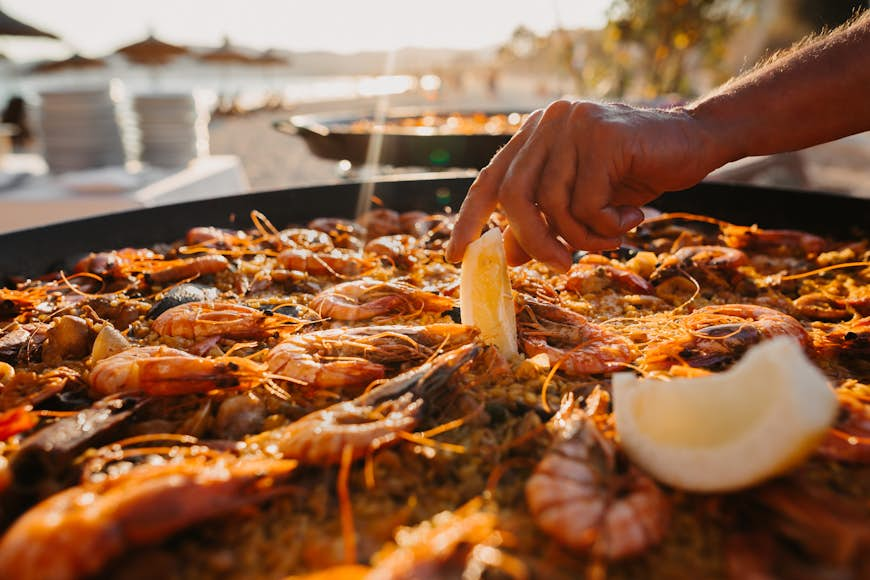 Best prepared by the sea and a must-eat in Spain: a traditional
Best prepared by the sea and a must-eat in Spain: a traditional
Linger over a decadent paella
There’s something life-affirming about a proper Spanish paella, warmly yellow like the sun and bursting with intriguing morsels. An inspired combination of vegetables, meat (or seafood), rice and saffron, cooked with stock in a single pan, paella is full of the promise of warm days and good company. It’s also one of the best-loved dishes of traditional Spanish cuisine.
Where to try it: Track down an authentic paella a la valenciana (cooked with beans, chicken and rabbit) in Valencia restaurants like the long-running Navarro.
Treat yourself to chocolate con churros
These deep-fried doughnut strips dipped in thick hot chocolate are a Spanish favorite for breakfast, afternoon tea or at dawn on your way home from a night out. They’re rich, sinfully filling and dusted in cinnamon sugar, so don’t go overboard!
Where to try it: Madrid’s Chocolatería de San Ginés is the most famous purveyor; open 24 hours, it’s a popular spot at the end of a big night out in the capital. Barcelona’s Gothic quarter has a narrow lane (Carrer de Petritxol) that’s famous for its chocolate shops, including Granja La Pallaresa.
Vegans and vegetarians
Some Spaniards, especially the older generation, don’t really understand vegetarianism or veganism: some would even include ham in cooked vegetable dishes. However, things are changing, with a growing number of vegetarian restaurants popping up in less urban places in addition to the many earth-friendly plant-based establishments in places like Madrid and Barcelona.
Menu items to seek out in traditional settings include verduras a la plancha (grilled vegetables); garbanzos con espinacas (chickpeas and spinach); and potato dishes, such as patatas bravas (potato chunks bathed in a slightly spicy tomato sauce) and tortilla de patatas (egg, potato and onion omelette).
The prevalence of legumes ensures that lentejas (lentils) and judías (beans) are also easy to track down, while pan (bread), quesos (cheeses), alcachofas (artichokes) and aceitunas (olives) are always easy to find. Tascas (tapas bars) usually offer more vegetarian choices than sit-down restaurants.
Where to try it: You can indulge in a changing selection of plant-based Andalucían tapas at Vegan Rock in Seville. Barcelona has a wealth of plant-based restaurants including the top-notch Sésamo in El Raval.
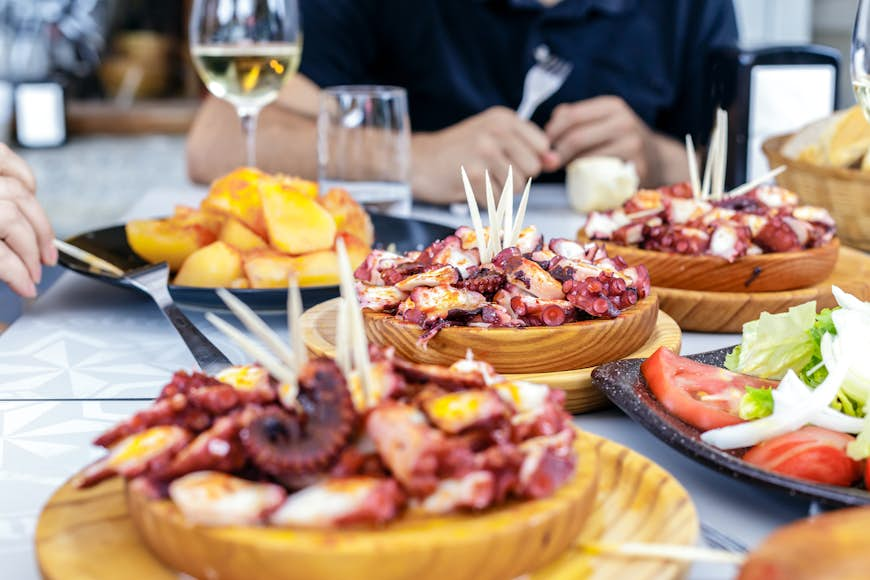 Another delectable seafood dish in Spain, Galician octopus dishes © iStockphoto / Getty Images
Another delectable seafood dish in Spain, Galician octopus dishes © iStockphoto / Getty Images
A year in food
Countless food festivals and a year-round growing season ensure there’s never a bad time to visit Spain when it comes to finding a memorable meal. Some dishes, however, are available at only certain times of the year.
November to February
Across inland Spain, winter is the time for fortifying stews (such as cocido or fabada) and roasted meats, especially cochinillo (suckling pig) and cordero (spring lamb). Catalans salivate over calçots, those large spring onions that are eaten with your hands and a bib, and romesco (a rich sauce of red peppers and ground almond).
March to May
Springtime brings delicacies associated with Easter, such as torrijas (sweet fried bread). This is also the prime season for asparagus (green and white) and atún (tuna).
June to August
The cold soups gazpacho and salmorejo, both specialties of Andalucía, only appear in summer. Rice dishes by the Mediterranean are another key ingredient of the Spanish summer.
September to November
La Rioja’s grape harvest gets underway in September. It’s well worth planning your trip around Logroño’s lively Fiesta de San Mateo.

